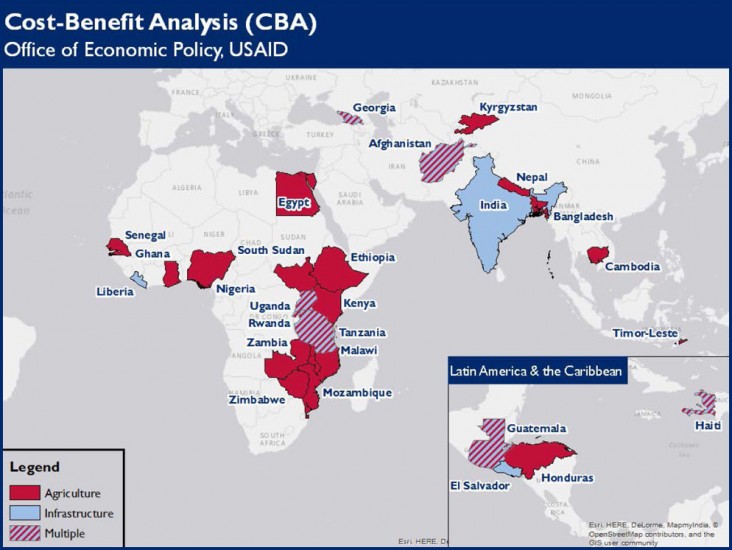- What We Do
- Agriculture and Food Security
- Democracy, Human Rights and Governance
- Economic Growth and Trade
- Education
- Ending Extreme Poverty
- Environment and Global Climate Change
- Gender Equality and Women's Empowerment
- Global Health
- Water and Sanitation
- Working in Crises and Conflict
- U.S. Global Development Lab
In 2010 USAID decided to look to Cost-Benefit Analysis (CBA) to strengthen the impact of its work, save money, and reduce the need for U.S. assistance over time. CBA typically includes: a) an analysis of the impact on beneficiaries, donors, and other stakeholders, and b) an assessment of project sustainability. CBA is used to identify improvements to existing programs or assess potential new programs. This is done by estimating the expected costs of implementing a project and comparing the costs to the benefits of the project over a long period of time.
CBAs provide answers to key design questions missions face, such as the following:
- Is the impact of the project worth the investment?
- What are the variables that are likely to determine the project’s success?
- Who stands to gain the most from this project, and who may lose the most?
- Will this project be financially sustainable after the intervention is complete?
These questions can be answered quantitatively, allowing for objective results to be compared across programs and countries. USAID is then better able to accurately assess Agency funding necessary to achieve a desired impact, as well as instances in which funds could be more productively used elsewhere.
Since 2010, USAID has analyzed more than 60 projects in 34 countries in the agriculture, power, water, roads, and global climate change sectors.
CBA Summaries and Documents
Below are summaries, project reports, and analytical models from CBAs conducted by USAID analysts and economists. This webpage will be updated regularly with additional CBAs. The key elements of these USAID CBAs can be found here. (PDF 45KB)
Guatemala
Economic Analysis of Feed the Future Investments in Guatemala: Rural Value Chains Project — AGEXPORT
The $23 million project implemented by local partner AGEXPORT supported rural producer associations to expand their reach, improve market linkages, and strengthen members’ ability to produce high-quality produce and export crops. These efforts were designed to directly improve agricultural production, increase incomes and diversify crops beyond subsistence levels in rural households in 12 municipalities in the Guatemalan Western Highlands by providing technical assistance to producer associations in these communities.
Bulk purchasing by the associations was intended to decrease the prices paid for inputs. Net benefits were analyzed separately for small, medium, and large coffee farms, with the largest benefits expected to accrue to the medium-sized farms. Overall, the project was expected to generate $75.2 million in incremental economic net benefits. Each farm will approximately earn an extra $10,000 on average over a 20-year period.
Project Documents:
- Full Report (PDF 229KB)
- Analytical Model (EXCEL 273KB)
Economic Analysis of Feed the Future Investments in Guatemala: Rural Value Chains Project — Anacafe
The Rural Value Chain Program (RVCP) with Anacafe intended to increase the number of rural households participating in value chains, increase incremental value chain sales and local employment, increase household incomes, and contribute to improved nutrition in the communities in which it works. This was to be accomplished by expanding the participation of poor rural households in productive value chains in horticulture, coffee and handicrafts, and linking those chains to local, regional, and international markets in rural households in 18 municipalities in the departments of San Marcos and Huehuetenango.
The CBA evaluated four out of six of the key program components that directly benefit coffee producers. The analysis found the RVCP to have a positive financial and economic net present value over the 20-year period, and that the farmers involved will benefit substantially: all non-organic farms are projected to return an incremental NPV of Q107 million ($14 million) over the 20-year horizon. Organic farms show an incremental NPV of Q14 million ($1.8 million).
Project Documents:
- Full Report (PDF 234KB)
- Analytical Model (EXCEL 136KB)
Nigeria
Economic Analysis of Feed the Future Investments in Nigeria: Maximizing Agricultural Revenue and Key Enterprise in Targeted Sites — MARKETS II
MARKETS II is USAID/Nigeria’s flagship project under their Feed the Future (FTF) Agricultural Transformation Program (ATP). For the five years following its creation in April 2012, MARKETS II aimed to sustainably improve the performance, incomes, nutrition, and food security of Nigerian poor rural farmers or smallholders in an environmentally appropriate manner through proven private sector demand-driven market interventions. The project aimed to help smallholder farmers access better inputs, adequate finance, better water management, appropriate technology, extension services, and improved nutritional uses of grown or purchased basic foods.
MARKETS II plans to invest $60.5 million in activities to benefit roughly 700,000 smallholder farms engaging in aquaculture, cassava, cocoa, maize, rice, sorghum, and soybean production. The CBA showed that farmers in all value chains benefit from USAID’s investment. In terms of the economic impact of the project, the results suggest that USAID’s investment in the Nigerian agricultural sector is adding over $613 million in present value to the economy over 10 years from surplus at the farm level.
Project Documents:
- Full Report (PDF 495)
- Analytical Model (EXCEL 1.3MB)
Cost-Effectiveness Analysis
Cost-effectiveness analysis (CEA) is an economic tool used to compare alternative interventions to determine which intervention can achieve a desired result at the lowest cost. Similar to CBAs, CEAs provide decision makers with rigorous analysis necessary to make informed decisions about budgets and priorities. CEAs are used to model sectors of the economy in which the benefits from desired outcome are not easily quantified, such as for improved public health and education outcomes. At USAID, CEA is conducted most often in cooperation with the Bureau for Global Health, but may be applied to any sector.








Comment
Make a general inquiry or suggest an improvement.